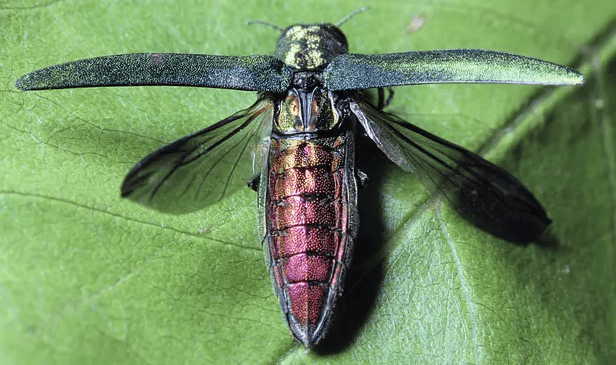The Emerald Ash Borer – The Midwest Ash Tree Assassin
Behold the emerald ash borer. This little sucker, albeit kind of pretty, is the John Wilkes Booth of beetles if you are an ash tree. Emerald ash borers (EAB) are an exotic, invasive, wood-boring insect that infests and kills native North American ash trees, both in forests and urban settings.
The EAB was first discovered in 2002 in Michigan. Since then, this Asian species has spread to nine states, including Missouri, resulting in the death of millions of ash trees. It wasn’t until July 2008 that they were discovered here in Missouri, and by September 2013, there was evidence of them in all 114 counties and the City of St. Louis. It is believed that the emerald ash borer probably arrived in the United States on solid wood packing material carried in cargo ships or airplanes arriving from Asia, and has most likely spread by hitchhiking on firewood transported among homes and recreation areas in at least 35 states.
How Emerald Ash Borers Infest Your Ash Tree
The cause of death in most ash trees due to an emerald ash borer infestation isn’t necessarily due to the insects themselves, but their eggs and larvae. The insects lay their larvae inside tree bark, where they feed on the sapwood inside the tree. Soon, there are enough larvae feeding on the sapwood inside the tree that vital water and nutrients are unable to reach the upper areas of the tree, eventually killing off the ash tree completely.
Symptoms To Look For
- Crown Dieback: Due to larval feeding, nutrient and water flow is disrupted up the trunk and limbs, causing nutrient depletion in the upper sections of the tree. This causes the loss of color and volume of leaves in the tree’s crown.
- Defoliation: Defoliation refers to the eventual complete loss of foliage (leaves) on the ash tree due to nutrient and water deficiencies.
- Bottom Growth: If you notice new branches growing from the bottom section of the trunk of an ash tree, chances are that the tree is infested with emerald ash borer within the bark. As a tree becomes more infested, it will attempt to survive and grow new branches wherever it can; usually below where the larvae are located.
- Woodpeckers: An infected ash tree is a feast for a woodpecker. Check trees for stripped bark, and for abnormal amounts of woodpeckers feeding on certain trees.
- Decline in Ash Population: Once an area has been placed under quarantine due to the appearance of emerald ash borer, your tree is highly likely to become infested if not treated immediately.
- Exit Holes: The exit holes of the emerald ash borer are distinctly D-shaped and small (about 1/8–1/4 of an inch).
Treating and Protecting Ash Trees from Emerald Ash Borer
The method of treatment depends on the severity of infestation.
Insecticide Treatment: There are specific professional-grade insecticides available to protect healthy trees from Emerald Ash Borer. When mixed with water, the insecticide is sprayed or injected around the base of a healthy ash tree and carried throughout the entire organism through the root system. Call a tree care professional to complete the task of applying insecticide safely and efficiently.
Treating an infested tree does not guarantee that it will be saved, as the insecticide may not be effective in killing all existing larvae.
Tree Removal and Replacement
Generally, once over thirty percent of a tree has been killed due to emerald ash borer, the best route of action is to completely remove the tree. This prevents the spreading of EAB to other ash trees in the area and increases safety by eliminating the chance of weak limbs crashing down. Many homeowners and cities choose to completely replace the ash tree with maple, birch, or other large shade trees with similar characteristics as the ash.
Trees are valuable. By choosing to protect ash trees before they have the chance to get infected can help save you a headache, money, and the environment. Jackson Tree Service can identify emerald ash borers in your Missouri neighborhood, and decide the best treatment for your ash tree. We also offer tree pruning, complete tree care, and tree removal if necessary, to protect Missouri’s ash trees. Call or text us for a free estimate at 314-423-9295

